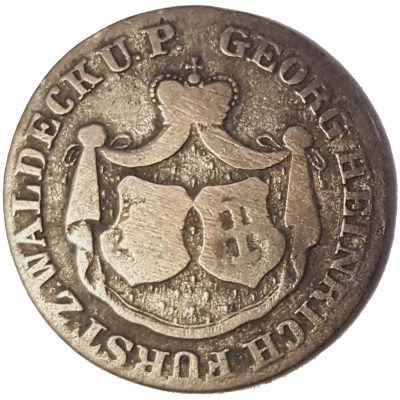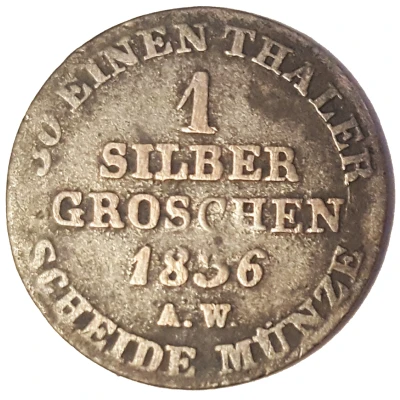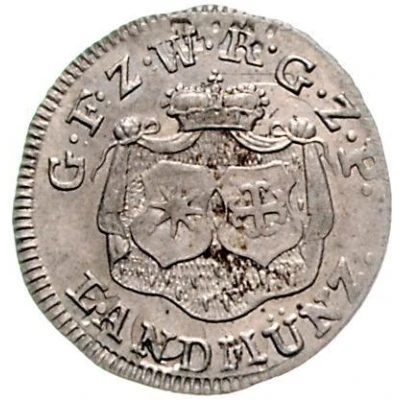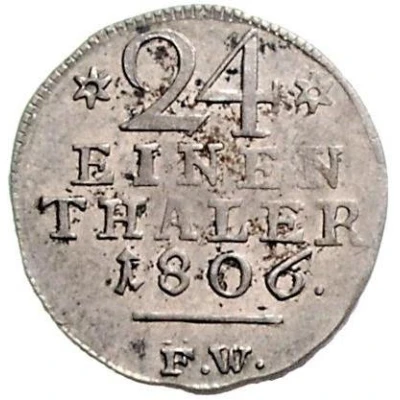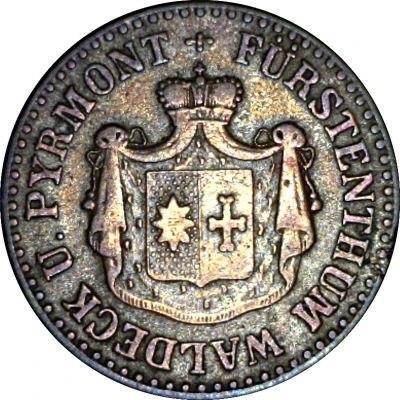
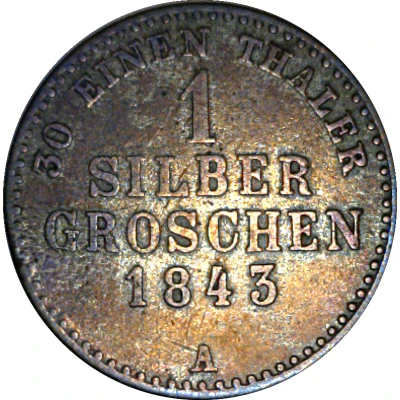

1 Silbergroschen - George Frederick Henry
| Billon (.222 silver) | 2.19 g | 18.5 mm |
| Issuer | Principality of Waldeck-Pyrmont (German States) |
|---|---|
| Prince | George II (Georg II) (1813-1845) |
| Type | Standard circulation coin |
| Years | 1842-1845 |
| Value | 1 Silbergroschen (1⁄30) |
| Currency | Thaler (1712-1848) |
| Composition | Billon (.222 silver) |
| Weight | 2.19 g |
| Diameter | 18.5 mm |
| Shape | Round |
| Technique | Milled |
| Orientation | Medal alignment ↑↑ |
| Demonetized | Yes |
| Updated | 2024-10-05 |
| Numista | N#173602 |
|---|---|
| Rarity index | 76% |
Reverse
Denomination and date.
Script: Latin
Lettering:
30 EINEN THALER
1
SILBER
GROSCHEN
1843
A
Translation:
30 in a Thaler
1
Silver
Groschen
Edge
Plain
Comment
The County of Waldeck (later the Principality of Waldeck and Principality of Waldeck and Pyrmont) was a state of the Holy Roman Empire and its successors from the late 12th century until 1929. In 1349 the county gained Imperial immediacy and in 1712 was raised to the rank of Principality. After the dissolution of the Holy Roman Empire in 1806 it was a constituent state of its successors: the Confederation of the Rhine, the German Confederation, the North German Confederation, the German Empire and, until 1929, the Weimar Republic. It comprised territories in present-day Hesse and Lower Saxony (Germany).Waldeck was a county within the Holy Roman Empire from about 1200. The ruling counts were a branch of the Counts of Schwalenberg (at Schwalenberg Castle). Waldeck Castle, overlooking the Eder river and first mentioned in 1120, was inherited by count Widekind I of Schwalenberg and his son Volkwin, from the counts of Itter and the counts of Ziegenhain, when they married wives of these families. Waldeck remained the main residence of the county until 1655.
Its counts included Adolf II of Waldeck from 1270 to 1276. In 1655, the residence was shifted from Waldeck to Arolsen. In 1625, the small county of Pyrmont became part of the county through inheritance, as it had also been ruled by a branch of the counts of Schwalenberg.
In January 1712, the count of Waldeck and Pyrmont was elevated to prince by Charles VI, Holy Roman Emperor. For a brief period, 1805 to 1812, Pyrmont was a separate principality as a result of inheritance and partition after the death of the previous prince, but the two parts were united again in 1812. The independence of the principality was confirmed in 1815 by the Congress of Vienna, and Waldeck and Pyrmont became a member of the German Confederation. From 1868 onward, the principality was administered by Prussia, but retained its legislative sovereignty. Prussian administration served to reduce administrative costs for the small state and was based on a ten-year contract that was repeatedly renewed for the duration of its existence. In 1871, the principality became a constituent state of the new German Empire. At the end of World War I, during the German Revolution that resulted in the fall of all the German monarchies, the prince abdicated and the principality became the Free State of Waldeck-Pyrmont within the Weimar Republic.
The princely house of Waldeck and Pyrmont is closely related to the royal family of the Netherlands. The last ruling prince, Frederick, was the brother of Queen consort Emma of the Netherlands.
In 1905, Waldeck and Pyrmont had an area of 1121 km2 and a population of 59,000.
Interesting fact
One interesting fact about the 1 Silbergroschen coin from the Principality of Waldeck-Pyrmont is that it was minted during a time of economic turmoil in the German States. The coin was introduced in 1842 as a replacement for the previous currency, the Thaler, which had become devalued due to excessive minting. The Silbergroschen was intended to stabilize the economy and restore confidence in the currency, and it was minted with a silver content of .222 silver, which was a significant increase from the Thaler's silver content of .168. Despite these efforts, the coin still faced challenges in circulation, as many people continued to prefer the use of foreign currencies, such as the Prussian Thaler.
Price
| Date | Mintage | VG | F | VF | XF | AU | UNC |
|---|---|---|---|---|---|---|---|
| 1842 A | 310000 | - | - | - | - | - | - |
| 1843 A | 191000 | - | - | - | - | - | - |
| 1845 A | 182000 | - | - | - | - | - | - |
Values in the table are based on evaluations by sales realized on Internet platforms. They serve as an indication only for 1 Silbergroschen - George Frederick Henry 1842-1845 coin.
